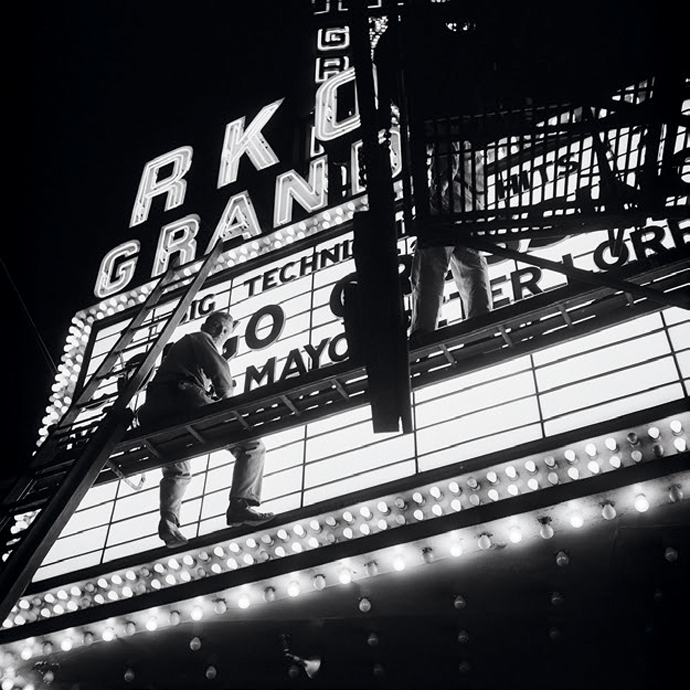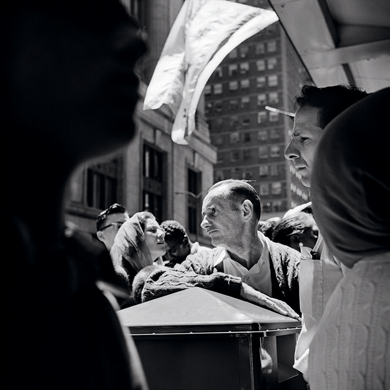Discussed in this essay:
Calm Sea and Prosperous Voyage, by Bette Howland. A Public Space. 336 pages. $26.

“Chicago, c. 1952,” by Vivian Maier. All photographs © The Estate of Vivian Maier. Courtesy Maloof Collection and Howard Greenberg Gallery, New York City
“I should explain right away that I didn’t belong here,” writes Bette Howland (1937–2017) in her 1974 memoir, W-3. “But that goes without saying, no one belonged here.” The “here” in W-3 refers to an inpatient psychiatric ward. After a suicide attempt in 1968, Howland—then a single mother of two, living in Chicago—received treatment at a university hospital. On the ward, the staff appeared to need help as urgently as the patients. Take Seymour Sobeloff, a physician who, rather than work with the residents, chooses to work on himself. He “spent all his time in Occupational Therapy making an ashtray out of colored tiles,” Howland writes, and attends just as thoughtfully to his dietary needs. Every night, the moment provisions for patients’ sandwiches appear in a common area, the doctor does, too:
Snapping open pop cans with a thick thumb, smearing mayonnaise, stacking sandwiches—a hand like a trowel. Three slices of bread at a time. Our ham! Our turkey! Down the hatch.
For Howland, insanity is a shared condition; all the world’s a ward. A neighbor in her later short story “To the Country” is “always twitching”; the narrator often wakes to find the woman’s “face against the screen, her hand to her forehead, peering in.” In the novella “German Lessons,” a landlady obsesses over a mother-in-law plagued by imaginary illnesses—and we ultimately learn that the mother-in-law is imaginary, too. Like a psychiatrist (a far more skillful one than Sobeloff), Howland tracks our madnesses and oddnesses, and, at her best, examines them with such humane patience that they ultimately come off as rather reasonable.
In addition to the questionable doctors, surprising rituals govern life on W-3. Patients perpetually hold elections, forcing one another to serve in community positions—Activities Director, or Recording Secretary—that no one wants. “It didn’t matter if the candidate begged off, pleaded, even broke down in tears; these were the ones who needed it most, it was always understood whom to vote for.”
In other words, “there were rules,” Howland notes. “There were plenty of rules, there was nothing but rules—the air was thick with them.” Howland was an attentive student of social rules; much of her work lies in a borderland between sociology and poetry. Her stories brim with marvelously peculiar people—many of whom, in one way or another, resemble Howland herself. In loving, lacerating sketches, she conveys Chicago’s libraries, courthouses, movie theaters, and old-age homes. All the while, she depicts the colorful citizens, often poor, who spend time in such establishments, pointedly fixing her gaze on those whom society overlooks. (She applies similar attention to her tales of family life, which explore exclusion and discomfort in a narrower context, and which sometimes overlap with her city chronicles.) “Let us speak frankly,” she writes in “Public Facilities.” “Where are people to go? People, I mean, who have no place to go.” And what do those people do there?
For that matter, where—in the decades between her literary success and the appearance, in May, of a selection of her work—had Bette Howland gone? Four years after publishing W-3, her first book, she put out her second, Blue in Chicago (1978), and won a Guggenheim fellowship. A MacArthur followed Things to Come and Go (1983), her third and final volume. Saul Bellow was a friend, mentor, and occasional lover; for decades, he supported her and her work. “I’ve rarely had such affectionate appreciation for anyone,” he wrote in a 1967 letter. “A surprising statement, now that I’ve written it. But then I seem to have dismissed certain forms of self-regard.” Reviewers showered appreciation on Howland, too, praising her humor, her voice, and above all her keen capacity for observation.
On one point they didn’t agree, however: What genre was Howland writing in? One critic called Blue in Chicago—a suite of narratives that explore the idiosyncrasies of city and family life—“a collection of dense, eloquent, meditative, largely autobiographical essays.” Another considered them “semi-autobiographical stories,” and yet another, “short, interlocking fictional pieces.” For Howland, the question was immaterial. “When people worry about whether something is fiction or nonfiction, they are worrying about how much invention there is,” she told the magazine StoryQuarterly. “They should be worrying about how much imagination there is. . . . There is very little invention in Blue. There is a lot of imagination.”
In applying the creative capacity of the fiction writer to her own life, Howland creates a perplexing if enticing experience for her reader: her fact-based accounts of everyday Chicago tilt toward storylike narrative, and the three novellas that constitute Things to Come and Go feel, at moments, like thinly disguised autobiography. With her flexible stance toward reality, her eye for the amusing, curious minutiae of existence, and her tonal range—she shifts easily between legato and staccato rhythms, between minor and major registers—Howland recalls the short-story writer Lucia Berlin, who worked at about the same time, and who has also, in recent years, seen a well-deserved revival of interest. Meanwhile, Howland’s devotion to Chicago situates her comfortably within the canon of that city’s portraitists, from Carl Sandburg through to Bellow himself. Her descriptions stand out not just for their sensitivity to alienation but also for their bursts of lyricism: in urban neighborhoods, “the prairie is always reasserting itself,” she writes, “pressing its claims.” She grounds such lush moments with clear-eyed reflections about poverty, racism, and crime, enhanced by a rare psychological acuity.
Despite her achievements, after Howland won the MacArthur, she stopped writing books. (Her son Jacob theorizes that the prize created unhelpful pressure: “I suspect she felt anything she published afterward had to justify the judges’ esteem.”) Eventually, her work fell out of print. By 2015—when Brigid Hughes, editor of the magazine A Public Space, discovered W-3 on a dollar cart at a New York City used-book store—few people, including Hughes, had heard of Howland. On a whim, Hughes bought the book. After reading it, she sought out Howland’s other work, as well as Howland herself.
At that time, the author was living in Tulsa, Oklahoma, suffering from multiple sclerosis and dementia. She would die two years later. But spurred by Hughes’s inquiry, Howland’s son discovered a trove of Bellow letters, as well as previously unpublished fiction and non-fiction, in a safe-deposit box. In 2015, A Public Space printed excerpts from the letters, in addition to a selection of Howland’s writing. The magazine has launched its new book imprint with Calm Sea and Prosperous Voyage, a crucial compendium of Howland’s work.

“Chicago, IL”
About half of Calm Sea and Prosperous Voyage consists of Blue in Chicago, a series of gritty, funny, harrowing descriptions of urban existence. At the Clark Theater, for instance, male patrons don’t always focus on the movie. “Slowly, stealthily, with painful efforts at concealment—extra distracting—his zipper starts to creak. Just a little at a time. Same way the ladies in the balcony peel their candy bars.” At the Chicago courthouse that Howland depicts in her story “Twenty-Sixth and California,” she hears a significantly more poignant sound:
They’re singing harmony in the lockup. Every time the clerk opens the door and sticks his head inside—calling a name into its barred depths—you can hear the notes escaping to a stomping rhythm.
The dazzling “Public Facilities” offers vivid representations of the city dwellers who spend time at a public library—often for surprising reasons. Inspired by Howland’s own work at a Chicago library, the piece consists of loosely connected anecdotes, one of which describes the “barroom bets” that arrive with every payday. “World records, batting averages; the age of the pope; the name of President McKinley’s assassin.” To find answers, the quibblers leave the bar and head for the stacks:
Three, four heavyset men, hot under the collar, elbowing and shoving. “This the reference?”
They fixed their eyes on the green blotter.
“We want to see a book. ‘If,’ a poem by Rudyard Kipling.”
The men intend to resolve a quarrel over a particular word (“wits” or “head”?), and when Howland tosses out the correct answer without consulting a source, they glare at her. “Talk is cheap, sister. Can you show us in a book?”
In such moments, Howland records the way Chicagoans actually speak: the casual diction, the swaggering tone, the musical mistakes. Delightfully, a Mr. Adorno—one of the library’s “regulars”—asks her to read his writing back to him, “to make sure it’s eligible.”
Who, exactly, are these regulars? They tend to be poor and elderly, people whose needs the city ignores—but whom Howland, movingly, does not. One is “Popkin, a thin, scraggly, timid-looking soul, with a scrawny neck and a military overcoat that dragged to his ankles—Russian Army issue.” The old man’s hair, she writes,
was thick as a cocoon and clamped in earmuffs, big black patches, that gave him the look of a horse in blinders. He always carried a book under his arm, pressed to his side. He was hatching it.
Howland applies the same care to describing a “club of elderly gentlemen” who “competed daily for possession of Barron’s and The Wall Street Journal.” The neighborhood around the library is desperately poor, “but the financial pages were in brisk demand, and the old men trembled when they asked—eyeing the drawer. ‘You don’t have today’s? Yesterday’s will do.’ ”
Just as the doctors of W-3 bear some resemblance to their patients, so do the librarians share some features with the regulars: they, too, have their quirks. Miss Rose, for instance, speaks in a shout, prompting patrons to shush her—a reversal of usual patterns. For mysterious reasons, Mrs. Speer devotes herself to cataloguing already catalogued books. At the library, “the level of tolerance for individual extremes was very high,” Howland writes. “It had to be—the facts were too peculiar.”
At the story’s climax, a hostile stranger appears in the building and threatens its gentle, if eccentric, denizens. “Goddamn all you lousy Jews,” he barks at Miss Rose. “Think you’re running the whole goddamn show. . . . You’re all a bunch of crazies, you know that? Misfits. That’s all you got.”
Misfits, perhaps—but fitter misfits than he’d banked on. “All over the room chairs were scraping. Pensioners rising; sleepers waking.” The elderly patrons challenge the interloper to a fistfight. Fed up with “being old, weak, damaged, done for, counted out,” they manage to eject him from the building.
But “Public Facilities” isn’t simply a heartwarming tale of triumph. When, toward the end of the narrative, the cops come, they show about as much concern for the victims’ well-being as their tormentor had: “Their eyes grazed over the faces. The weak, the outraged, the indignant. Big deal. Hey, grandpa. Isn’t it about time you were home in bed?” As for the original aggressor, he seems mentally ill (he fears someone is “eavesdropping on him—stealing his thoughts—tuning in on his secrets”). What inspired him to stop by the library in the first place? He probably has nowhere to go, either.
When Howland isn’t portraying the strangers around her, she’s portraying her own intimates—wonderfully strange people themselves. Born on the West Side of Chicago, Howland grew up in a Jewish family whose boisterous dysfunction electrifies much of her work. In a typically amusing, and confusing, incident from “Birds of a Feather,” in Things to Come and Go, an elderly aunt pokes a “big black fingernail” at the mouth of the narrator, Esti, a version of Howland. She then pokes at her own. “Are you choking?” young Esti demands, alarmed. “Are you thirsty?”
Clarity arrives soon enough. Tante Malkeh pries open the girl’s mouth, and,
her old eyes lighted up in their sunken depths.
“Kinnehora,” she said, clicking her tongue—this to ward off the Evil Eye—and putting her head first to one side, then the other. “So many. So many.”
She laid a hand to her cheek. She was admiring my teeth. And she counted them, each and every one, from end to end and top to bottom.
Bafflement is, for Howland, a common feature of family interactions, as characteristic as the “beard-blued cheeks” and “palpable noses” of Esti’s relatives. Language divides are partly to blame. Esti’s most meaningful moment of communication with her grandfather, who, like Howland’s grandparents, spoke Yiddish, was a sneeze. “Got-choo! Got-you! That was a surprise. So he sneezed in English.” She hopes that, at some point, he’ll say something else she can understand—but “he never did.”
Yet literal foreignness can explain only so many of these miscommunications. Howland’s father, born in the United States, did speak English—but you wouldn’t always know it from her depictions of him. In the autobiographical title story from Blue in Chicago, the father loads his letters with clichés: “Be a Good Girl. Apply Yourself. Obey Your Mother. Don’t Disappoint . . . Your Dad.” In another memoiristic story from the collection, an emotional divide distances daughter and mother: “After all these years,” Howland writes, “I still don’t speak her language.”
Howland addresses the first story in Calm Sea and Prosperous Voyage, “A Visit,” to an unidentified “you”—someone who, we eventually realize, has passed away. That choice stands in for a painful theme in her writing, especially her writing about family: the people to whom she has the most to say are often the very people who can’t hear her.

“April 20, 1956. Chicago, IL”
The title story in the collection comes last, and it mirrors the first; here, too, the narrator speaks to a “you” who has died. The densely allusive tale describes her complex relationship with one Victor, a character based on Howland’s son’s university mentor. Like Howland’s family members, Victor tends to distance as much as to draw close, to bewilder as much as to reassure.
Despite Victor’s expertise in Greek and Hebrew, his magnetic pull on women, and his exaggeratedly gangly frame (which, Howland observes, could qualify him for the centerfold of Ectomorph Magazine), he isn’t the most interesting person in the story. That credit goes to his ex-wife, whom Howland refers to simply as X. The progeny of a long line of Jewish scholars, X was born in war-torn Europe, starved while hiding in the woods, and landed, orphaned, in a refugee camp. An American couple adopted her; to them, she seemed “a sacred relic, a living symbol, like those Torah scrolls recovered from the smoke and rubble of cremated synagogues.” X, then, doesn’t merely stand for “ex-wife.” It also refers to a crossing-out, a cancellation of countless people (so countless that they might be represented by the variable x). It alludes to exclusion, exile, and extermination.
Howland rarely engages with the horrors of Jewish history; her Chicago Jews are fairly comfortable in their environs. And yet one senses, in her boundless fascination with the unsettled and in-between, a link to the difficulties her own group has faced. Sometimes this connection becomes explicit. For X, the embodiment of Jewish displacement, the hardship continues well beyond childhood. At the conclusion of her disastrous marriage to Victor, X demands a get—the divorce document required to terminate marriages between observant Jews. Only a husband can provide a get, and if he refuses to do so, his wife endures severe consequences. Lacking the decree, a woman becomes an agunah—a word that comes from the Hebrew for “chained.” Howland writes: “A woman without a get is like a man without a country . . . unmarried, unmarriageable, unprotected, without status in this world or the next.”
Victor sets about getting a get—until a rabbi tells him he doesn’t need one. Since Victor’s own ancestry is partly Christian, Orthodox authorities don’t consider him Jewish. Thus, his marriage was never valid in the first place. Poor X doesn’t fit anywhere: she has managed to become neither Victor’s wife nor, even, his agunah.
Yet agunah remains an oddly apt term for this odd woman out. X calls Victor repeatedly. She appears at his home, “beating down [the] door” with “tiny bare fists.” She lurks outside his windows. She even inserts herself in his funeral planning. “I see now what you must have seen,” Howland writes. “The agunah. A lost soul, an accursed soul—unwanted, abandoned, unloved—wandering the worlds. Wandering in search of you.”
The narrator is a bit of an agunah herself—seeking her place, still connected to a man who’s gone. “Tell me, Victor, where should I go?” she asks. “Where do I belong? I’m not your student, not a colleague, not family; no longer a lover. I don’t want to be alone, not just yet; and the only one I want to talk to is you.”
The matter of belonging arises again and again in Howland’s writing, in every context imaginable, from the university hospital to the public library to the refugee camp to the mundane family outing. Throughout her work, Howland illuminates our seemingly limitless talent for rejecting each other, our proclivity for designing systems that absorb some of us, but never all. And yet, in noting outsiders in so many situations, she confers on them a kind of normalcy. They belong everywhere as well as nowhere.
In “Birds of a Feather,” Esti meets another haunting European émigré: her uncle Daniel, who survived a pogrom and, afterward, internment at Auschwitz. Years later, when his American family tracks him down, they bring him to the United States.
Esti can’t speak with this mysterious figure, who knows no English. But they experience an idiosyncratic kind of contact at a family gathering. He falls asleep while sitting next to her, and, Howland writes:
first his sleeve slid off the arm of the couch. I poked it with my elbow and it pulled right back. I hadn’t meant to wake him, but, in no time, it happened again. His arm began slipping sideways.
Repeatedly, she nudges him; he half-awakens; he falls asleep again and droops in her direction; she nudges again. This awkward physical exchange provides an apt metaphor for the strained familial communication Howland describes elsewhere, the halting advances and withdrawals. Here, it offers an additional resonance: Esti’s uncle is her link to her vanished European relatives and their dreadful fates—a link that feels tenuous at best. Esti is unable to engage her uncle in conversation, to ask him what he’s seen. Instead, she can merely poke him. She hasn’t just lost family members; she’s also lost the ability to know about them.
Tellingly, Esti’s family avoids speaking about Daniel’s history, even in their common language. After he dies, a relative asks incredulously whether all the terrible stories she’s heard are true:
First the pogrom, and all of them getting killed off that way? And then the aunt that was taking care of him dying in an epidemic? And then that Russian farmer that got hold of him? And then the Russian Army. Which side were the ones that made him a prisoner? Weren’t they fighting each other? I can’t keep it straight. And then the Germans. And the camps. My God.
“What’s the use a talking?” replies Esti’s uncle. “Let him rest. We don’t know nothing about it. We ain’t ever gonna know.” His comment reflects a subtle yet profound form of alienation. The family is estranged from its own history—estranged forever, since they can’t talk to their dead.
Yet Howland herself repeatedly addresses the dead. It’s as though, despite her preoccupations with displacement and miscommunication, she maintains some hope of intimacy, of understanding, of return. The last name she gives Victor provides a clue: it’s Lazarus. And she ends her address to her absent companion by sharing a thought we might direct to her: “It’s all over—and it’s only the beginning.”



